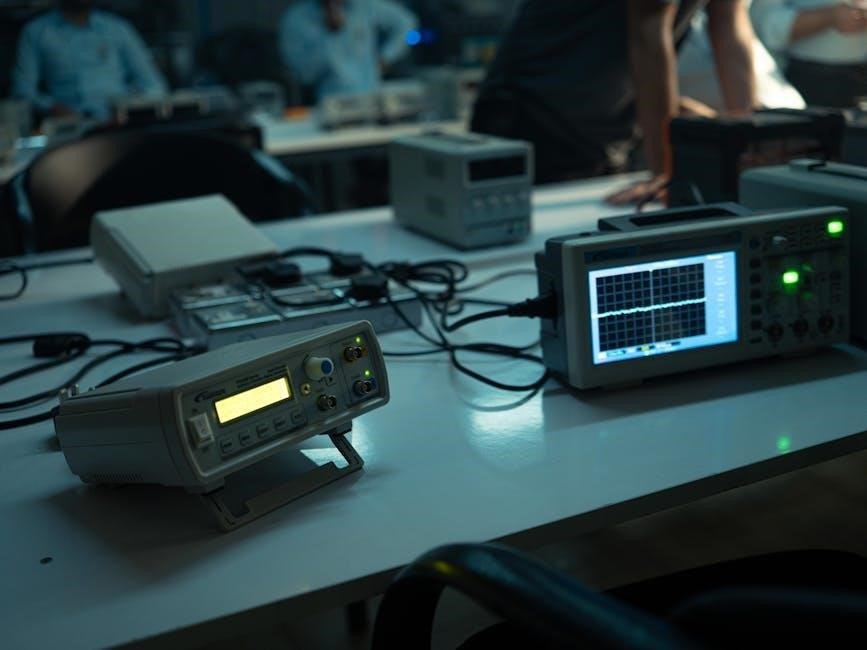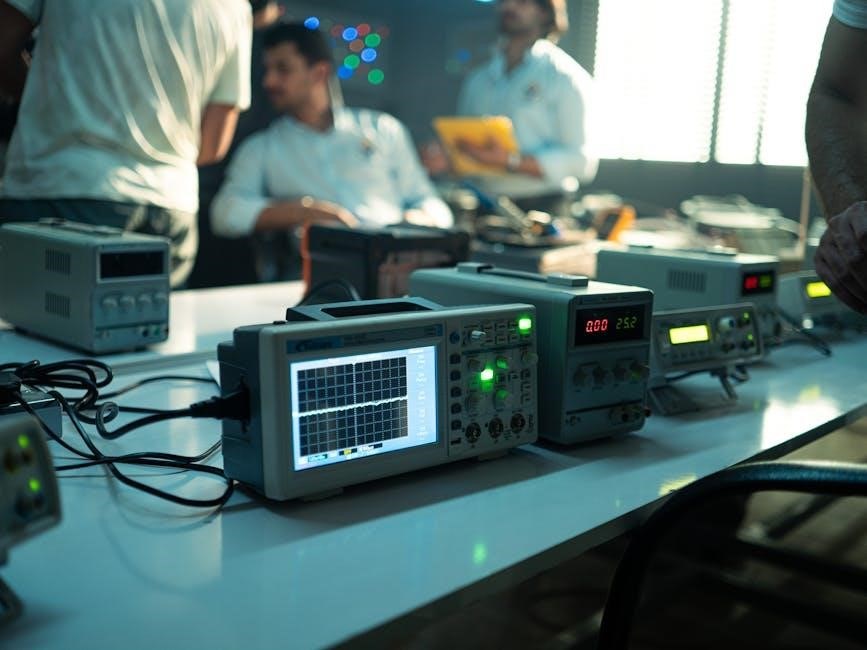“The Musician’s Guide to Theory and Analysis” by Jane Piper Clendinning and Elizabeth West Marvin offers a comprehensive approach to understanding music theory. This guide uses a phrase model approach to explain how music works in context, making it accessible for students. It combines theoretical concepts with practical applications, providing a valuable resource for musicians to deepen their understanding of music structure and composition. The text is pedagogically innovative and theoretically current, ensuring relevance for modern learners. This guide bridges the gap between theory and practice, helping musicians analyze and appreciate music more effectively. It serves as a foundational tool for both beginners and advanced students seeking to master music theory and its practical applications in various musical genres and styles.
Why Music Theory Matters for Musicians
Music theory is the foundation of musical understanding, providing tools to compose, improvise, and communicate ideas effectively. It enables musicians to analyze and appreciate the structure of music, fostering creativity and technical skill. By studying theory, musicians gain insight into chord progressions, scales, and harmony, which are essential for crafting meaningful compositions. The Musician’s Guide to Theory and Analysis emphasizes how theory applies to real-world music-making, helping musicians connect intellectual understanding with practical performance. This knowledge empowers musicians to express themselves more precisely and innovate within their craft, making theory an indispensable part of every musician’s journey.
Understanding the Basics of Music Notation
Mastering music notation is essential for reading, writing, and interpreting music. It provides a universal language for musicians to communicate pitches, rhythms, and dynamics. The Musician’s Guide to Theory and Analysis introduces the fundamentals, such as staff notation, clefs, note values, rests, and time signatures. Understanding notation allows musicians to decode musical ideas accurately and express their own creativity clearly. This foundational knowledge also aids in analyzing compositions, identifying patterns, and performing with precision. By grasping these basics, musicians can unlock the full potential of music theory, enhancing their ability to compose, play, and appreciate music at a deeper level.

The Foundations of Music Theory
Music theory’s foundation includes notes, scales, intervals, and rhythm. These elements form the core of musical structure, enabling composition and performance; Mastering them enhances creativity and understanding.
Key Signatures and Accidentals
Key signatures indicate which notes are consistently sharped or flatted in a piece, simplifying notation. They appear at the beginning of a staff, following a specific order of sharps or flats. The circle of fifths helps determine key signatures, with each key adding or removing a sharp or flat. Accidentals, like sharps, flats, and naturals, alter specific notes within a piece, overriding the key signature. Understanding key signatures and accidentals is crucial for interpreting music correctly and maintaining tonal consistency. These elements form the backbone of musical notation, guiding pitch and harmony throughout a composition.
Intervals and Chord Construction
Intervals measure the distance between two pitches, forming the foundation of harmony. They can be harmonic (simultaneous) or melodic (sequential) and are classified as major, minor, perfect, diminished, or augmented. Intervals are numbered from unison (1st) to octave (8th). Chord construction begins with triads—three-note chords built in thirds. Major, minor, diminished, and augmented triads are the basics. Seventh chords add a fourth note, creating richer harmonies. Understanding intervals and chord construction is essential for composing, analyzing, and improvising music. These elements provide the harmonic structure that underpins musical composition and performance, enabling musicians to create meaningful and cohesive soundscapes.
The Major and Minor Scales
The major and minor scales are fundamental elements of Western music, defining tonality and emotional expression. A major scale follows the WWHWWWHF interval pattern (whole-whole-half-whole-whole-whole-half), creating a bright, uplifting sound. The natural minor scale uses WWHWWWF, producing a melancholic or somber feel. Both scales consist of seven notes within an octave and serve as the basis for melody and harmony. Understanding these scales is crucial for composition, improvisation, and analysis. Variations like harmonic and melodic minors expand their expressive range, making them indispensable tools for musicians to craft meaningful musical narratives.

Harmony and Chord Progressions
Harmony and chord progressions create the vertical structure of music, guiding emotional expression and tonal movement. Chords built from scales form progressions that establish harmonic stability and tension.
Diatonic Harmony and Functional Chords
Diatonic harmony revolves around chords constructed from the notes of a key, adhering to its tonal center. Functional chords—tonic, dominant, subdominant, and pre-dominant—serve specific harmonic roles, guiding music’s emotional and structural progression. The tonic establishes stability, while the dominant creates tension, resolved through cadences. Subdominant chords add contrast, and pre-dominant chords intensify the harmonic journey. These functions are fundamental to crafting cohesive, expressive chord progressions. Understanding diatonic harmony and functional chords is essential for composing, improvising, and analyzing music within a key-centered framework. Their interplay defines the harmonic language of tonal music, providing a foundation for both simplicity and complexity in musical expression.
Modulation and Key Changes
Modulation is the process of shifting a musical composition from one key to another, creating contrast and adding variety. It often involves pivot chords or tones that belong to both the original and new keys. Types of modulation include direct, where the change is sudden, and indirect, using transitional material. Key changes can enhance emotional depth, surprise listeners, or signal structural shifts. Effective modulation relies on harmonic planning and smooth transitions. Understanding this technique is crucial for composers and analysts to appreciate how music evolves and maintains listener engagement through tonal shifts and harmonic development. It expands the expressive possibilities of a piece.

Understanding Musical Form
Musical form refers to the structure of a composition, organizing elements like melody, harmony, and rhythm into coherent patterns. Common forms include binary, ternary, sonata, and rondo, each providing a framework for musical expression and listener comprehension.
Binary and Ternary Forms
Binary form consists of two distinct sections, often labeled AB, where each section contrasts in melody, harmony, or rhythm. Common in dances and songs, it provides a straightforward structure for expression. Ternary form, or ABA, features an opening theme (A), a contrasting middle section (B), and a return to the first theme (A). This form emphasizes balance and unity, frequently used in minuets, scherzos, and songwriting. Both forms offer composers a clear framework, guiding listeners through musical development while maintaining coherence and emotional impact.
Sonata Form and Rondo Form
Sonata form is a large-scale structure commonly used in instrumental works, particularly in symphonies, sonatas, and chamber music. It typically consists of three main sections: exposition, development, and recapitulation. The exposition introduces themes and establishes tonality, while the development explores and transforms these themes. The recapitulation resolves the themes, often with a dramatic climax. Rondo form, meanwhile, features a recurring main theme (A) alternated with contrasting episodes (B, C, etc.), creating a sense of variety within unity. Both forms provide composers with frameworks for extended musical narratives, balancing structure and creativity.
Rhythm and Meter in Music
Rhythm and meter are fundamental to music, defining patterns and structure. Time signatures establish meter, while note values and rests create rhythm. Syncopation and polyrhythms add complexity.
Time Signatures and Note Values
Time signatures and note values are essential for understanding rhythm and meter in music. A time signature indicates the number of beats per measure and the type of note that receives one beat. Common time signatures include 4/4 (common time) and 3/4 (waltz time). Note values, such as whole, half, quarter, and eighth notes, specify durations, while rests indicate silence. Dots and ties modify note lengths, adding flexibility to rhythmic expression. Understanding these elements is crucial for interpreting sheet music and performing with precision, as they form the backbone of musical timing and structure.
Syncopation and Polyrhythms
Syncopation involves emphasizing off-beat or unexpected rhythmic patterns, creating rhythmic tension and interest. It often involves rests or tied notes that disrupt the regular flow of a meter. Polyrhythms occur when two or more conflicting rhythms are played simultaneously, such as 3 against 2, adding complexity to the musical texture. Both techniques are widely used in various genres, from jazz to world music, to enhance rhythmic expression and depth. Mastering syncopation and polyrhythms requires a strong sense of timing and coordination, as they challenge conventional rhythmic structures and expand musical possibilities.

The Role of Tonality and Atonality
Tonality provides harmonic structure and emotional depth, while atonality explores freedom from traditional key centers, offering innovative and complex musical expressions.
Tonal Music and Its Structure
Tonal music revolves around a central pitch, or tonic, establishing a hierarchical system of chords and scales. This structure creates harmonic coherence and emotional resonance, guiding listener expectations. Key elements include the tonic-dominant relationship, functional harmony, and resolution patterns. The major and minor scales provide the foundation for melody and chord construction, while cadences signal structural endings. Tonal music often follows traditional forms, such as sonata or binary forms, ensuring clarity and balance. Understanding tonal structure is essential for composing, analyzing, and performing music effectively, as it underpins the harmonic language of Western music tradition.
Atonal Music and Its Characteristics
Atonal music rejects the hierarchical structure of tonal harmony, abandoning a central key or tonic. This approach, prominent in early 20th-century works, emphasizes dissonance and chromaticism, creating a sense of tension and ambiguity. Composers like Arnold Schoenberg and Alban Berg explored atonality, often leading to serialism. Atonal music avoids traditional chord progressions, instead focusing on pitch-class sets and unconventional harmonies. It challenges listeners’ expectations, offering a diverse and complex soundscape. This style requires advanced analysis techniques to uncover its underlying organizational principles, which may include motivic development or textural innovation rather than functional harmony.

Advanced Music Analysis Techniques
Advanced music analysis involves intricate methods like thematic development tracking, harmonic innovation studies, and structural mapping to uncover complex compositional strategies in musical works.
Schönberg’s Method of Analysis
Arnold Schönberg’s analytical methods emphasize thematic development and structural coherence, focusing on how musical ideas evolve and transform. His approach highlights the importance of motivic fragmentation and the underlying unity in complex works. Schönberg’s techniques, particularly his use of reduction and voice leading analysis, reveal the harmonic and contrapuntal foundation of music. This method is especially valuable for understanding atonal and serial compositions, offering insights into the composer’s intent and the work’s organization. Schönberg’s legacy has profoundly influenced modern analytical practices, providing a deeper understanding of musical structure and innovation.
Fragmentation and Development in Music
Fragmentation and development are essential techniques in musical composition, where themes or motifs are broken down and transformed to create coherence and variety. Fragmentation involves splitting larger ideas into smaller, manageable parts, which are then developed through variation, elaboration, or expansion. This process allows composers to explore different harmonic, rhythmic, and melodic possibilities while maintaining thematic unity. Development often occurs in transitional sections, such as bridges or solos, where artists reinterpret and evolve musical material. These techniques are crucial for building tension, conveying emotion, and sustaining listener engagement across a piece, making them fundamental to both classical and contemporary music composition.

Practical Application of Music Theory
Music theory provides tools for composition, improvisation, and analysis, enabling musicians to create coherent, emotionally resonant works while understanding structure, harmony, and rhythm in various genres.
Analyzing a Song from a Real Musician
Analyzing a song from a real musician involves breaking it down into its core components: melody, harmony, rhythm, and form. Start by identifying the key signature and chord progressions, which reveal the song’s harmonic structure. Look for recurring motifs or themes and how they develop throughout the piece. Pay attention to the use of scales and modes, as well as any deviations from traditional tonality. Examine the rhythmic patterns and time signatures, noting syncopation or polyrhythms. Understanding these elements provides insight into the artist’s creative decisions and how music theory shapes their work. This process enhances both appreciation and musicianship.
Improvisation and Music Theory
Improvisation is deeply rooted in music theory, as it relies on understanding scales, modes, and chord progressions. Musicians use theory to create coherent, emotionally resonant solos or melodies on the spot. Knowledge of key signatures, intervals, and harmonic structures enables improvisers to navigate chord changes seamlessly. Rhythmic awareness, including time signatures and syncopation, adds complexity and groove. While improvisation is spontaneous, it thrives within the framework of music theory, allowing artists to express creativity while maintaining musical integrity. This interplay between theory and instinct is what makes improvisation both accessible and limitless for musicians.

Historical Context of Music Theory
Music theory evolved from ancient Greek philosophers like Pythagoras to medieval scholars, shaping modern notation and harmony. The Renaissance and Baroque periods refined these concepts, influencing classical composers.
The Evolution of Music Theory
Music theory has evolved significantly over centuries, shaped by cultural and technological advancements. Ancient civilizations, such as the Greeks, laid the foundation with concepts like intervals and scales. The Middle Ages introduced notation systems, while the Renaissance brought polyphony and counterpoint. The Baroque period refined harmony and basso continuo. Classical and Romantic eras expanded harmonic complexity and form. The 20th century saw the rise of atonality and serialism, challenging traditional tonal structures. Today, music theory integrates diverse styles, from jazz to electronic music, reflecting global influences and innovative compositional techniques. This evolution underscores music theory’s adaptability and enduring relevance.
Key Composers and Their Contributions
Bach laid the groundwork for Western music theory with his counterpoint mastery and compositions like the Well-Tempered Clavier. Beethoven expanded harmonic possibilities, bridging Classical and Romantic styles. Wagner introduced chromaticism and leitmotifs, influencing dramatic music. Schoenberg revolutionized theory with atonality and the 12-tone method. Stravinsky pioneered rhythmic complexity and neoclassicism. These composers not only advanced theoretical concepts but also redefined musical expression, leaving lasting impacts on composition and analysis. Their works remain central to studying music theory, offering insights into harmony, form, and innovation across centuries.

Learning Music Theory Independently
Master music theory through self-study using books, online courses, and practice exercises. Set goals, review concepts regularly, and apply theory to real music for better understanding and skill retention.
Resources for Self-Study
For independent music theory learning, utilize textbooks like “Harmony and Theory” by Mark Levine and “Music Theory for Dummies.” Explore online platforms such as Coursera, Khan Academy, and Teoría.com for structured lessons. Apps like Tenuto and Theory Lessons offer interactive exercises. Join forums such as Reddit’s r/musictheory for community support. Subscribe to YouTube channels like Adam Neely and 12tone for engaging explanations. Use sheet music tools like MuseScore to analyze compositions. Regularly practice with workbooks and compose short pieces to apply concepts. Consistency and practical application are key to mastering theory independently.
Online Courses and Tutorials
on Coursera or “Music Theory for Musicians” on Udemy. These resources blend structured learning with practical exercises, ensuring a deep understanding of theory and its application.
Balancing Music Theory with Practical Playing
Mastering music theory enhances practical skills, while playing strengthens theoretical understanding. Together, they foster creativity and technical mastery, enabling musicians to express ideas effectively in performance.
Playing by Ear vs. Playing by Theory
Playing by ear relies on intuition and auditory skills, enabling spontaneous performance without formal notation. Playing by theory involves using musical structure and rules to guide execution. While ear playing fosters creativity and emotional connection, theory-based playing ensures technical accuracy and comprehension of complex compositions. Musicians often combine both approaches, using theory to enhance their ear and vice versa. This blend allows for deeper expression and adaptability, whether improvising or interpreting written music. Balancing these methods creates a well-rounded musician capable of both intuitive and informed performances.
Overcoming the Fear of Music Theory
Music theory can seem intimidating, but it doesn’t have to be. Many musicians initially feel overwhelmed by its complexity, but breaking it down into manageable parts makes it accessible. Start with the basics, like understanding notes and rhythms, and gradually build your knowledge. Practice regularly, even in short sessions, to reinforce concepts. Use interactive tools or apps to make learning engaging. Remember, theory is a tool to enhance your music-making, not a barrier. Embrace it as a way to deepen your creativity and connection to music, and don’t be afraid to ask for help or guidance along the way.

The Role of Technology in Music Theory
Technology revolutionizes music theory learning by providing interactive tools, software, and platforms that enhance understanding and practical application, making complex concepts more accessible for musicians.
Software Tools for Music Analysis
Software tools like Finale, Sibelius, and MuseScore enable musicians to compose, edit, and analyze music with precision. These programs offer features such as chord analysis, interval identification, and MIDI manipulation. Tools like Ableton Live and Logic Pro integrate music theory with production, allowing for deep exploration of harmony and rhythm. Additionally, apps such as Theory Lessons and Tenuto provide interactive exercises for learning concepts like scales and chord progressions. These tools also support ear training and sight-reading, making them invaluable for both education and professional use. By leveraging technology, musicians can gain insights and enhance their creative processes effectively.
